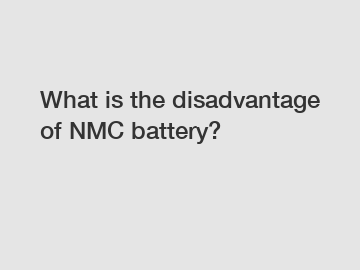What is the disadvantage of NMC battery?
When it comes to electric vehicles and energy storage systems, NMC batteries have become a popular choice due to their high energy density and long lifespan. However, like any technology, NMC batteries also have their disadvantages that need to be considered before making a decision. In this blog post, we will explore some of the drawbacks of NMC batteries and how they can impact their performance and sustainability.
One of the main disadvantages of NMC batteries is their tendency to degrade over time, leading to a decrease in capacity and overall performance. This is due to the chemical reactions that occur within the battery during charging and discharging cycles, which can cause the electrodes to break down and lose their ability to store and release energy efficiently. As a result, the battery's lifespan may be shortened, requiring more frequent replacements and increasing the overall cost of ownership.
Another drawback of NMC batteries is their sensitivity to high temperatures, which can lead to thermal runaway and even fire or explosion in extreme cases. This is a serious safety concern, especially in electric vehicles where the battery is subjected to high heat levels during operation. To mitigate this risk, manufacturers often incorporate additional cooling systems and safety features, which can add to the overall complexity and cost of the battery system.

Additionally, NMC batteries are also known to have a lower power density compared to other types of lithium-ion batteries, which can limit their ability to provide high levels of energy output in a short amount of time. This can be a significant drawback in applications where rapid charging and discharging is required, such as electric vehicles or grid storage systems. To address this issue, researchers are exploring new materials and designs that can improve the power density of NMC batteries without compromising their energy density or overall performance.
Furthermore, NMC batteries also contain toxic and rare materials, such as cobalt and nickel, which can have a negative impact on the environment and human health. The mining and extraction of these raw materials can contribute to environmental destruction and pollution, while their disposal at the end of a battery's lifespan can lead to contamination of soil and water sources. As a result, there is a growing concern over the sustainability of NMC batteries and the need for more eco-friendly alternatives that do not rely on these harmful materials.
Despite these disadvantages, NMC batteries still remain a popular choice for many applications due to their high energy density, long lifespan, and relatively low cost. However, it is important for consumers and manufacturers to be aware of these drawbacks and actively work towards finding solutions that can address these issues and improve the overall performance and sustainability of NMC batteries.
In conclusion, while NMC batteries offer many benefits in terms of energy storage and power delivery, they also come with their own set of disadvantages that need to be carefully considered. By understanding these drawbacks and working towards solutions to mitigate them, we can ensure that NMC batteries remain a viable and sustainable option for the future of electric vehicles and energy storage systems.
If you want to learn more, please visit our website china lifepo4 battery, prismatic lithium ion batteries, 36v forklift battery.

Comments
0